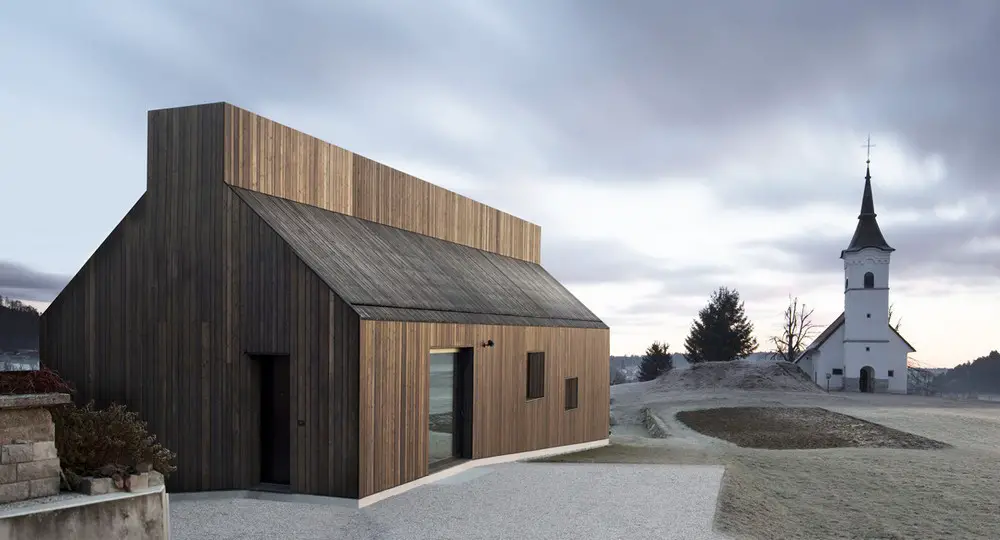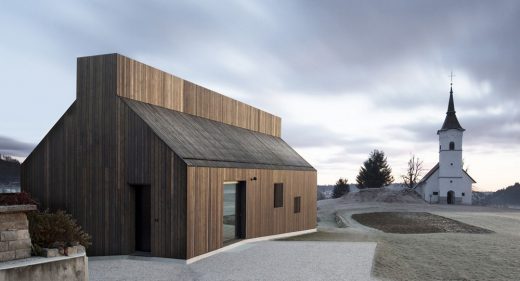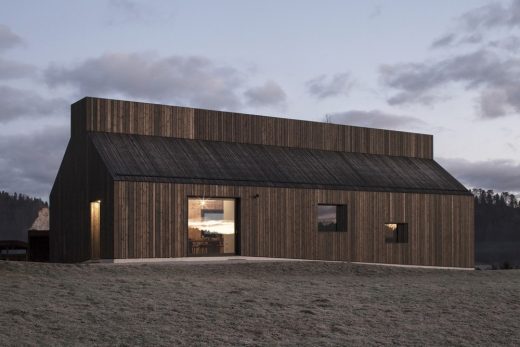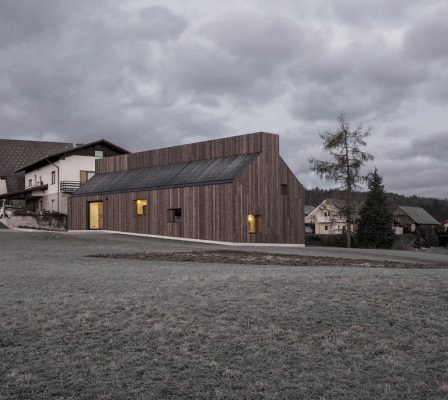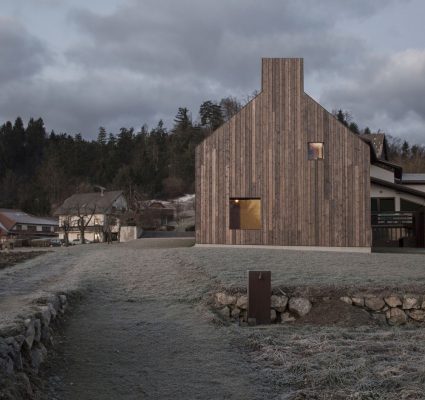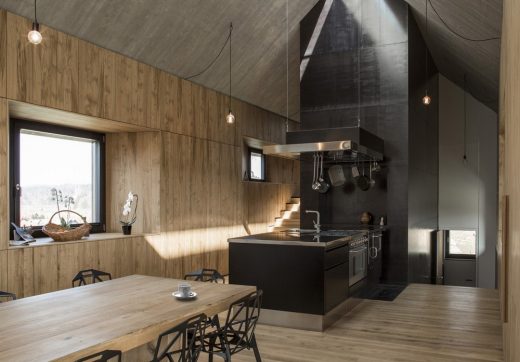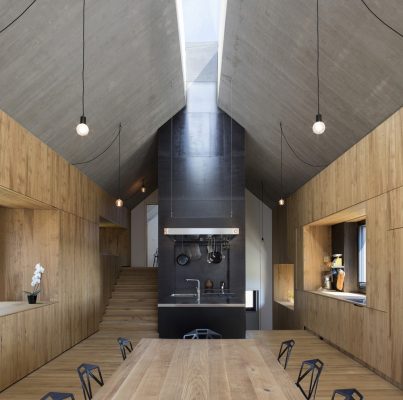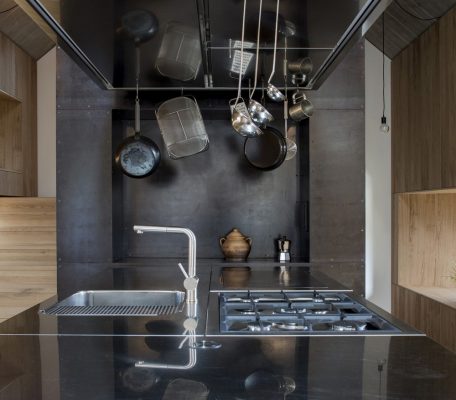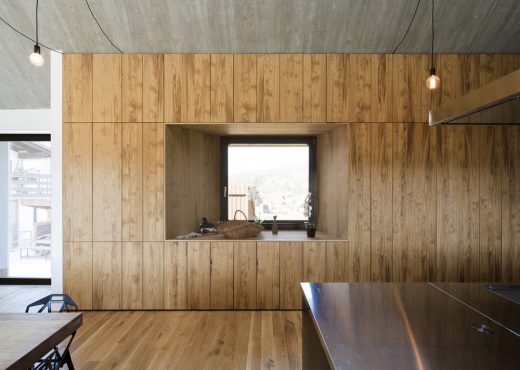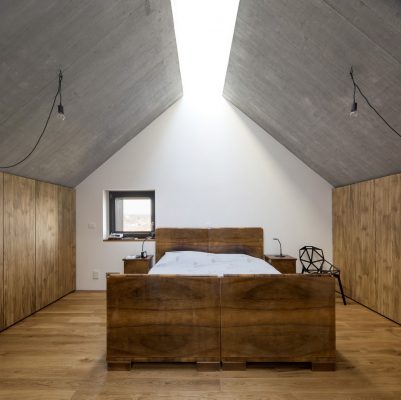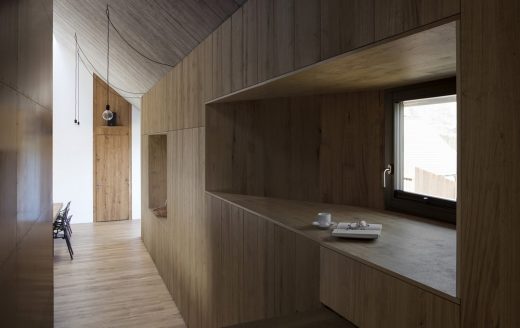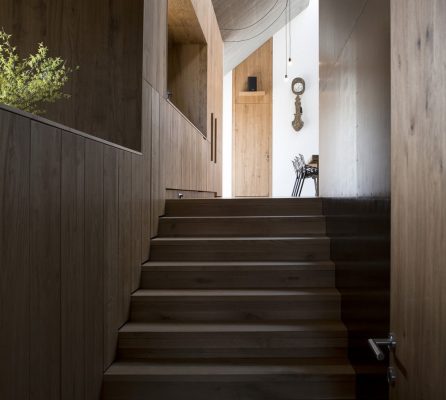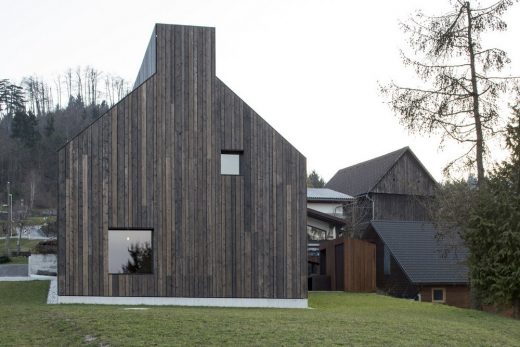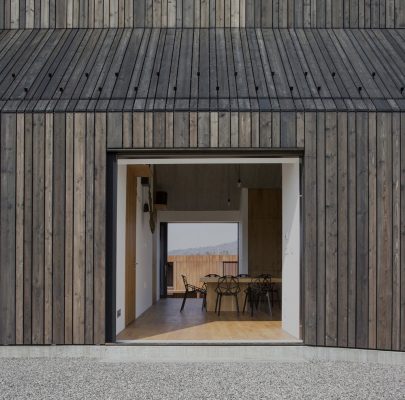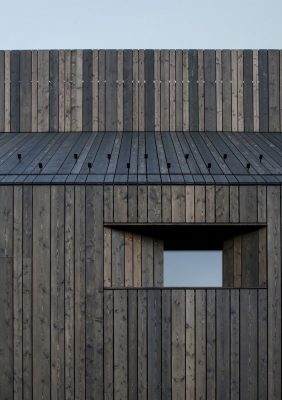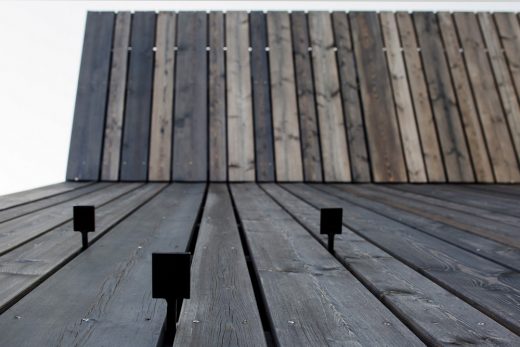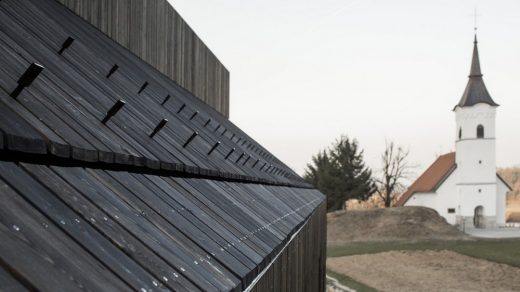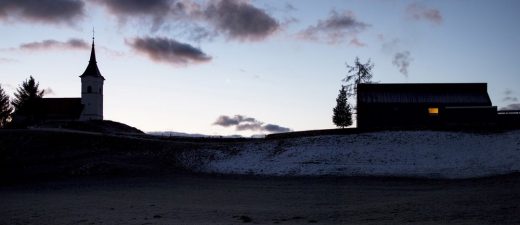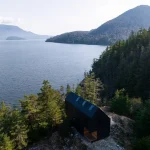Chimney House, Contemporary Slovenian Home, Architect, Residential Design, Architecture Images
Chimney House in Logatec
Contemporary Slovenian Home design by dekleva gregorič architects
30 Mar 2017
Chimney House, Slovenia
Design: dekleva gregorič architects
Location: Logatec, Slovenia
Chimney as an element of typological transformation
Photos : Flavio Coddou
The design of the Chimney House in Logatec is primarily based on the rules of local architecture. It respects the morphology of the traditional built context, referring to the prevailing gabled roof type of the house and respecting its volumetric and material parameters. On the other hand the Chimney house marks typological transformation generated by the users’ specificity.
The kitchen, with a multifunctional wood stove, plays the vital role in the private and social life of a couple living in the countryside. Stove’s centrally positioned chimney determines the concept of the house informing the centrally aligned layout of spaces within the specific cross-section of the house. The ridge of the roof is pushed apart creating a continuous skylight running throughout the house’s linear volume and providing top light for all the crucial spaces.
Positioned on the borderline of the village it clearly relates to the adjacent wooden barn with the dark wooden materiality, but with the new distinctive volumetric identity moves deliberately away from its vernacular neighbour and curiously associates with the nearby 16th century church creating a dialogue between the two.
Oiled larch boards completely define the materiality of the outside relating to the traditional finish of the vernacular barn. Deliberate secondary wooden roof cladding provides the continuity of the dark wooden materiality of the facade cladding. The building’s envelope is developed as a thick wall integrating multiple storage spaces, secondary kitchen, and small ‘inhabitable’ window niches that carefully curate incoming light and expanding views to the surroundings.
Interactive capabilities allow for an array of activities. Material definition of the interior responds to haptic abilities of inhabitants: oiled oak is used for all the surfaces that can be reached and touched by the human body, whereas the structure of the roof is in reinforced concrete showing the imprint of the wooden formwork that provides for the continuity of the texture of interior envelope.
Rising the gaze, starting from the material inner envelope and moving towards the zenith, one can discover and observe ever changing condition of the sky that becomes part of everyday life in the house.
Extract from the essay ‘Transformed Archetype’ by Jure Grohar:
author of the essay: Jure Grohar; published in Home by dekleva gregorič architects – Ljubljana: Museum of Architecture and Design (MAO), 2016 // p.134-137
“In The Chimney House, one could easily find references to the Slovene vernacular and critical regionalist modern architecture, local craftsmanship etc. But these references aren’t as essential, as the most interesting question that poses itself is how a single archetypal architectural element became the central theme of the house and how this influenced the spatial concept, perception and the volumetric articulation of the object.
Architecture is often ‘separated’ into architectural and technical components, the technical aspect of which is usually understood as a banal necessity, or even an obstacle in expressing a ‘clean’ architectural idea. In this case the ‘technical’ aspect becomes the challenge and one of the most important bases of the project.
Historically, the chimney is one of the first technological elements which appeared in architecture, along with the fireplace – the source of warmth, light and food preparation became the centre of the home. The chimney with its ‘fireplace’ gives meaning, in an archaic way, to the kitchen and dining area – the central dwelling space. … The volume of the house is, in a way, of an archetypal shape, transformed by the outline of the chimney.”
About dekleva gregorič architects:
dekleva gregorič architects is an architectural practice based in Ljubljana, Slovenia and founded by Aljoša Dekleva and Tina Gregorič. Alongside their architectural practice they are intensively involved in reshaping approaches to architectural education.
Aljoša Dekleva is Programme Director of Architectural Association Visiting School Slovenia, and was only recently Guest Professor of Architecture at UdeM, Montreal, Canada. Tina Gregorič is Professor of Architecture at TU Wien, Austria. They lecture extensively both in Slovenia and abroad, presenting their practice and their research.
Tina and Aljoša both graduated from the Faculty of Architecture in Ljubljana and later received Master degrees in Architecture with Distinction at the Architectural Association (AA) in London (AADRL 2002), after which they established Dekleva Gregorič architects in 2003. Initially they began with research on topics of user participation and mass-customization of collective housing at the AA in London, and are co-authors of the book Negotiate my boundary!, published by AA Publications and Birkhauser.
The book received intense professional attention, related particularly to the social models of sharing and co-habitation. Recently they initiated and led a distinctive design research project on nanotourism, a participatory, locally oriented alternative to the current downsides of conventional tourism. Together with their research team at BIO50 (Biennial of Design, Ljubljana, 2014) they received the biennial’s highest honour – Best Collaboration Award.
Their practice attempts to pursue the concept of ‘research by design’ and ‘design by research’ through diverse projects, through different scales and programs as well as diverse climates and localities. Understanding of the specific constrains and conditions of the context become the ultimate generative tool that aims to challenge the obvious. They utilize a systematic design approach to establish an intense structuring of space and to challenge the use of materials by exposing their primary natures.
The user experience of architecture and participation continue to constitute the practice’s central objective. Topics like new collectivity, sharing, participation and collaboration frame a social position to architecture that aims to stimulate new interaction with or between users, encourage user participation in the design process and customization according to users’ needs.
Their built projects and research have received many international and national awards; among others, several nominations for the Mies van der Rohe Award, for Metal Recycling Plant, Housing Perovo, Compact Karst House and the Cultural Centre of EU Space Technologies (KSEVT), a collective work by four Slovenian architectural studios. In 2013 the practice was named Highly Commended at the 21 for 21 WAN AWARDS 2012 – a search for “the 21 architects for the 21st century. The initiative aims to highlight outstanding, forward-thinking people and organizations who have the demonstrable potential to be the next big thing in the architectural world.”
Several Dekleva Gregorič projects explore the topic of home and dwelling, including their first project, the internationally awarded and exhibited, 43 m2 XXS house built in 2004 in central Ljubljana. In 2012 their project Clifftop house on Maui, Hawaii received the AIT Award and International Architecture Awards 2012.
Recently, they have managed to improve social interaction with a series of small but distinct shared spaces as part of large collective housing project Brick neighbourhood in Ljubljana.
In 2015 they explored the potentials of redefining regional tradition and condensed family life in Compact Karst House, which won the WAN House of the Year 2015 Award, Best architects 16 Award, and was commended in the prestigious AR House Award 2015, by Architectural Review, UK. Architects Aljoša Dekleva and Tina Gregorič tend to continuously question the role of architecture in an attempt to improve our society.
Chimney House Logatec – Building Information
subtitle: chimney as an element of typological transformation
location: Logatec, Slovenia
Design office: dekleva gregorič architects
Project team: Aljoša Dekleva u.d.i.a., M.Arch. (AA Dist); Tina Gregorič u.d.i.a., M.Arch.
(AA Dist); Vid Zabel stud.arch., Primož Boršič m.i.a
Client: Andrej Dolenc
Site area: 830 sqm
Build up area: 145 sqm
Net area: 205 m2 (106 m2 ground floor + 99 m2 basement)
Project date: 2012
Completion date: 2016
Photographer: Flavio Coddou
Chimney House in Logatec images / information received 300317
Location: Logatec, Slovenia
Slovenian Architecture
Slovenian Architecture Designs – chronological list
Slovenian Architecture – Selection
Buildings / photos for the Chimney House in Logatec page welcome
Website: dekleva gregorič architects

